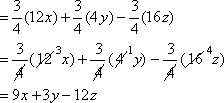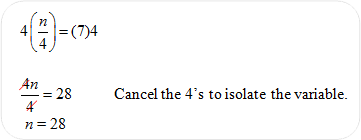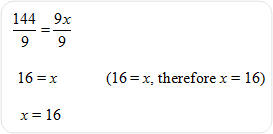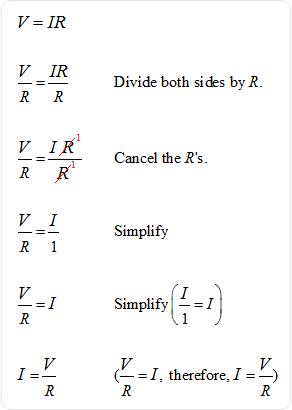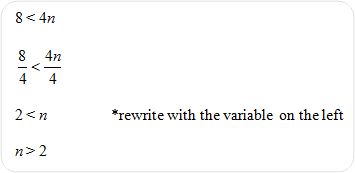EXPRESSIONS, EQUATIONS, AND INEQUALITIES
 |
Unit Overview
In this unit you, will learn about one of the most important and widely used properties in algebra, the distributive property. Throughout the unit, you will use this property to simplify expressions and solve equations and inequalities. The unit will conclude with graphing inequality solutions.
Distributive Property
One of the most important properties in algebra is the distributive property. This property ties addition or subtraction together with multiplication. The distributive property allows you to write expressions in different forms and is given with the following definition.
 |
To rewrite an algebraic expression using the distributive property make sure that you multiply each term inside the parentheses by the number on the outside. Take a look at the following examples.
This problem is complete because 3m and 24 are not like terms and cannot be combined. |
In any algebraic expression, the numbers and variables are called terms. Therefore, in the expression 3m – 24 from above, the 3m and the 24 are considered the terms of the expression. If the terms contain the same variable with the same exponent, they are considered like terms.
Examples of like terms:
*Notice in the last example that both x’s have an exponent of 2. This makes them like terms. |
Examples of terms that are not like terms:
*Notice that the last example does not represent like terms because the exponent on the x in the first term is 3, whereas the exponent on the y in the second term is 3. If they are going to be like terms, each variable must have the same exponent. |
Example #2: 5(2q – 7r – 9)
This problem is complete because 3m and 24 are not like terms and cannot be combined. |
Example #3:
|
Stop! Go to Questions #1-5 about this section, then return to continue on to the next section.
Simplifying Expressions
Expressions are in simplest form when there are no parentheses and no like terms. Like terms can be combined by adding or subtracting the numbers in front of the variables. These numbers are called the coefficients of the term and will be referred to as such throughout the course.
| Example: The coefficient of 4x is 4, Examples of simplifying: |
| 1) | 10y – y | The coefficient of y is understood to be “1”. |
10y –1y |
||
(10 –1)y |
||
| 9y | This is in simplest form. |
|
| 2) | 3x + 4 + 8x | 3x and 8x are like terms, combine them. |
| 3x + 8x + 4 | ||
| (3 + 8)x + 4 | ||
| 11x + 4 | This is in simplest form. |
|
| 3) | 6(b + 3) + 7b | Use the distributive property to eliminate the parentheses. |
| 6b + 18 + 7b7b | Combine 6b and 7b as they are like terms. | |
| (6 + 7)b + 18 | ||
| 13b + 18 | ||
| 4) | 2(x + y) + 3(2x + 3y) | Use the distributive property. |
| 2x + 2y + 6x + 9y | Rearrange so the x’s and the y’s are beside each other. | |
| 2x + 6x + 2y + 9y | Combine like terms. | |
| (2 + 6)x + (2 + 9)y | ||
| 8x + 11y | ||
| 5) | 6x + 4y – 3x + 12y | Rearrange so the x’s and the y’s are beside each other. |
| 6x – 3x + 4y + 12y | Combine like terms. |
|
| (6 – 3)x + (4 + 12)y | ||
| 3x + 16y | ||
| *Notice that when the –6 is distributed over the –2, the result is +12. | ||
| 6) | 7(x2 + 2y) – 5x2 | Use the distributive property |
| 7x2 + 14y – 5x2 | Combine like terms.* | |
| 7x2 – 5x2 + 14y | ||
| (7 – 5)x2 + 14y | ||
| 2x2 + 14y | ||
*Notice that the exponent (2) did not change. When combining like terms, the exponent STAYS THE SAME. |
||
| 7) | 2.3s + 5.7r – 1.1s + 3.6r | Combine like terms. |
| (2.3 – 1.1)s + (5.7 + 3.6)r | ||
| 1.2s + 9.3r | ||
Stop! Go to Questions #6-10 about this section, then return to continue on to the next section.
Solving One-Step Equations
 At this point in our unit, we will begin to solve simple equations.
At this point in our unit, we will begin to solve simple equations.Click here to view a video that will help you understand using variables and keeping the equations balanced when solving them.
A mathematical sentence such as 374 + x = 795 is called an equation because it contains an equal sign.
The solution to an equation is the value of the variable that results in a true statement. The process of finding this solution is called solving the equation which uses opposite operations in order to isolate the variable. When we say opposite operations, we mean the opposite of adding is subtracting, the opposite of multiplying is dividing, and visa versa.
At this point it, should be mentioned that an equation must be balanced. This means that whatever is done on one side of the equation must also be done on the other side of the equal sign.
Let’s take a look at a few examples of solving equations.
Example #1: Solve x + 4 = 17
|
Example #2: Solve
|
Example #3: Solve y – 26 = 38
|
Example #4: Solve 5n = 75
|
Example #5: Solve 144 = 9x
|
Stop! Go to Questions #11-18 about this section, then return to continue on to the next section.
Literal Equations and Formulas
Sometimes in math and science classes it is necessary to rewrite an equation or a formula to highlight another quantity of interest. When given formulas with more than one variable, we solve for the stated variable.
For example, let's look at Ohm's Law:
 |
| This formula is written with the voltage (V) as the quantity of interest. If the problems at hand were to find the voltage, given numerical values for amperes and resistance, then this formula would be easy to follow and finding the actual voltage would be a simple substitute and multiply problem. However, if the quantity of interest was finding amperes (I), then the formula would change to |
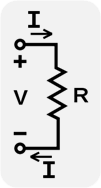 |
Let's take a look to see how this idea simplifies the work in the long term. We will continue to use inverse operations to solve for the new quantity when more than one variable is within the equation.
Example #1: Given the formula d = rt where d represents distance, r represents rate or speed, and t represents time, solve the formula for t, so that t is the quantity of interest. |
![]() Read the formula to yourself mathematically. How is it read?
Read the formula to yourself mathematically. How is it read?
The formula is read d equals r times t.
"Click here" to check the answer.
![]() Locate the variable. d = r t What variable are you solving for?
Locate the variable. d = r t What variable are you solving for?
t
"Click here" to check the answer.
![]() Now ask yourself: “What is being done to this variable that needs undone?”
Now ask yourself: “What is being done to this variable that needs undone?”
The variable t is being multiplied by r.
"Click here" to check the answer.
![]() What is the inverse of multiplication?
What is the inverse of multiplication?
Division
"Click here" to check the answer.
![]() What do we need to do to both sides of the equation to "undo" the multiplication?
What do we need to do to both sides of the equation to "undo" the multiplication?
Divide both sides by r.
"Click here" to check the answer.
Now, let's look at the math for our steps.
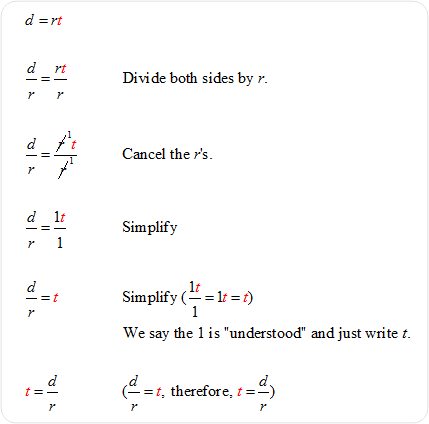 |
*Note: When we have just t (or 1t) on one side of the equation, we can say that we isolated "t ." This is a common expression used in algebra.
Solving a literal equation such as this one would be useful in science class if you were examining the time elapsed for various objects knowing the distance and rate. You would use the inverse operation one time then plug the values into your newly defined formula.
Now let's revisit Ohm's Law.Example #2: Solve Ohm's Law V = IR for I.
When the literal equation is in this form, finding the amperage (I ) would be a simple substitute and divide problem. |
Stop! Go to Questions #19-22 about this section, then return to continue on to the next section.
Solving One-Step Inequalities
An inequality is a mathematical sentence that contains one of the following symbols:
< |
“less than” |
> |
“greater than” |
≤ |
“less than or equal to” |
≥ |
“greater than or equal to” |
Just like equations, inequalities are solved by using opposite operations. The one exception is that when multiplying or dividing by a negative number, flip the inequality sign. We will address this issue in the next unit when we study integers.
Let’s take a look at a few examples of solving inequalities. *Note: it will be easier to understand the solution set if you write your answer with the variable on the left. (You will see what this means in example #2.)
Example #1: Solve n – 7 < 22
This solution means that all numbers (n) less than 29 are a solution to the inequality. |
Example #2: Solve 48 ≥ 6y
This solution means that all numbers y, that are less than or equal to 8, are a solution. |
Example #3: Solve
This solution means that all numbers z, that are less than or equal to 242, are a solution. |
Stop! Go to Questions #23-29 about this section, then return to continue on to the next section.
Graphing Inequality Solutions
The solution set of an inequality can be graphed on a number line in the following manner:
| -If < or >, use an open circle ( |
| -If ≤ or ≥ use a closed circle ( |
Once you have determined if you are going to use an open circle or a closed circle, you will shade the part of the number line that includes the solution set.
Let’s take a look at a couple of examples:
Example #1: Solve and graph.
This solution tells us that all values “less than or equal” to 12 will result in a true statement. Follow the steps below to graph this inequality solution.
|
Example #2: Solve and graph.
This solution tells us that all values “less than or equal” to 12 will result in a true statement. Follow the steps below to graph this inequality solution.
|
Stop! Go to Questions #30-33 to complete this unit.
